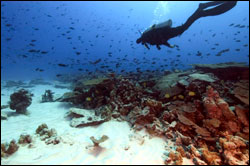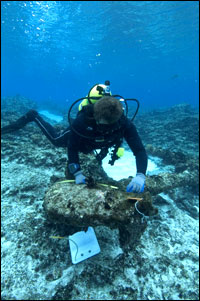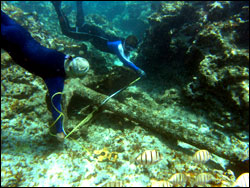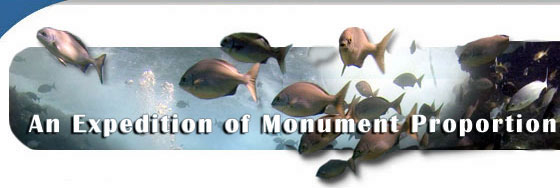|
Maritime Archaeology in the Northwestern Hawaiian Islands
Hans Van Tilburg, Ph.D.
NOAA National Marine Sanctuary Program
In June and July of 2006 a team of six maritime archaeologists from NOAA’s Maritime Heritage Program will embark upon the second maritime heritage expedition to the Northwestern Hawaiian Islands aboard the NOAA ship Hi’ialakai. During the 28 day research expedition, the team will return to several known shipwreck sites at Kure and Pearl and Hermes Atolls. The team’s work in June and July will continue the systematic survey, documentation and interpretation of these unique maritime heritage resources. Maritime archaeologists have only just begun to uncover hundreds of years of seafaring history in these remote atolls where approximately 120 vessels and aircraft have been reported lost.
The Northwestern Hawaiian Islands are a remote and challenging location to conduct a research expedition. Weather, research vessel time constraints, and the complications of working in a dynamic reef environment all contribute to the need for special planning for maritime heritage expeditions to this area. Pacific Islands Region maritime archaeologists are beginning to establish a protocol for annual underwater archaeological survey at these and other remote sites, as well as develop a better understanding of the environmental processes relative to the spur and groove topography and wave action at these coral atolls. Continued research in 2006 will help maritime archaeologists understand the way that these atolls influence the formation of shipwreck sites hundreds of years after their loss.
First Stop: Kure Atoll
 | | A scientist descends upon the reef in the Northwestern Hawaiian Islands. |
The research expedition aboard the NOAA ship Hi’ialakai begins at Kure Atoll, the furthest west from the main Hawaiian islands, and one of the last locations to be accurately and precisely located by mariners. This low treacherous atoll, with no historic aids to navigation, possesses seven documented ship wrecks. The expedition will begin with six days of dive operations planned for the maritime archaeology team at Kure Atoll. Rough weather in 2005 limited the team’s work to the calmer waters of the lagoon inside the atoll, which facilitated the documentation of the bow section of a 19th century whaleship thought to be the remains of the Parker, lost in 1842. In the 2006 expedition, divers plan to return to the site of the USS Saginaw, first discovered by a team of maritime archaeologists in 2003. The story of the Saginaw and the open ocean rescue voyage has become legacy in the US Navy, and tells an amazing story of survival at sea.
In 1870, the USS Saginaw, a fourth-rate gunboat, was returning a small group of Boston hard hat divers from Midway Atoll to San Francisco. They had spent six months on the barren island attempting to open a channel into the lagoon for the use of steam ships in the Pacific. Lieutenant Commander Montgomery Sicard, deciding to check nearby Ocean Island (Kure) for castaways, set course to the west at a stately three knots, planning on arriving after daybreak. His navigation was dead on, but (unaware of the local currents) the Saginaw went onto the coral reef at 3 a.m. Ninety-three of her crew were stranded for two months, while five volunteers set sail in the captain’s modified gig for Honolulu. The 31-day open ocean crossing covered some 1,500 nautical miles in heavy weather. The sailors were emaciated and weakened when their boat moved onto the fringing reef on Kauai. Four of them, including Lietenant John Gunnel Talbot, died in the surf on the north shore. The sole survivor, coxswain William Halford, staggered ashore and passed out from loss of blood. Revived the next day, he immediately notified both the U.S. Minister and King Lot Kamehameha V, the last direct descendant of Kamehameha the Great, of his shipmates’ plight. The opportunity to further document this site, and interpret the material remains of this historic vessel of the “old steam navy” is an exciting aspect of this research expedition to the NWHI. Maritime archaeologists hope that further study of the USS Saginaw site will uncover a more complete view of the entire shipwreck and complete the fascinating story of the Saginaw survival story.
Moving Onto Pearl and Hermes Atoll
 | | Maritime archaeologist documents a 19th century anchor at Pearl and Hermes Atoll. |
Following work at Kure Atoll, the maritime heritage team will continue with six more days of dive operations at Pearl and Hermes Atoll, home to two of the oldest shipwrecks so far discovered in Hawaiian waters. Pearl and Hermes Atoll has the distinction to be named after the wrecks of the sister ships Pearl and Hermes, British whalers. The 262-ton Hermes ran aground on the unseen reef on the 26th of April at about 4 a.m., and the 320-ton Pearl (actually an American-built ship captured by the British in the War of 1812) ran aground nearby a few minutes later, reportedly about a quarter mile to the east. Both were stuck fast and eventually broken on the sharp coral. The combined crew totaling 57 souls were castaway with what meager provisions they could salvage on a nearby island for months. One of the carpenters on board the Hermes, James Robinson, supervised the building of a small 30-ton schooner named Deliverance on the beach. Though most of the crew elected to board the passing ship Earl of Morby, Robinson and 11 others were able to recoup some of their financial losses from the wreck by taking possession of the nearly finished Deliverance, sailing her back to Honolulu, and eventually selling her there for $2,000. From there Robinson went on to found the highly successful James Robinson and Company shipyard in 1827 and became an influential member of the island community.
The NOAA Coral Reef Ecosystem Division marine debris first discovered the whaling shipwrecks at Pearl and Hermes Atoll in 2004 when divers found numerous trypots (cauldrons for boiling whale oil), anchors, bricks (from the tryworks structure on deck), whaling implements, fasteners, copper sheathing, cannon, and other hardware scattered on, around, and even under the shallow coral reefs of the atoll. Though a positive identification has yet to be made, the only records of whaling ships lost at Pearl and Hermes Atoll are, indeed, the British registered whalers Pearl and Hermes themselves (for which the atoll has been named), vessels of the South Seas Whaling Industry based in London.
The Pearl and the Hermes may be the only vessels of the British South Seas Whaling Industry ever discovered in an archaeological context. These are the oldest shipwrecks yet discovered in the Hawaiian Islands. Yet relatively little is known of the construction of the vessels themselves, and only a few tantalizing clues exist as to the tragic events on the coral reef and small sandy island at the distant atoll. Further site work in 2006 may tell us more about this event and provide a window into our historic maritime past. Archival search, as well as collaborative interpretive work at London’s Dockyard Museum, the New Bedford Whaling Museum, and elsewhere, is currently underway. In 2005, the maritime archaeology team used a combination of permanent datums, baseline trilateration, digital photography and GPS positioning to generate data for site plans and artifact interpretation. The same research design will continue in 2006 to fully document and interpret these unique sites.
 | | Maritime archaeologists document a 19th century anchor at Pearl and Hermes Atoll. |
Work to fully identify and interpret these sites has just begun. The whaling shipwrecks at Pearl and Hermes Atoll contribute to the story of an important era in Hawaiian history when the whaling industry expanded American commerce to the far reaches of the globe and led ships through the remote atolls of the Northwestern Hawaiian Islands. These are rare sites, glimpses into our past, and deserve our best survey and preservation efforts. Work in 2006 will focus on further documentation of these sites in greater detail. A complete study of these sites, however, will take several years due to the limited time allowed at each site in such a remote location.
There is little doubt that the Northwestern Hawaiian Islands possess some of the most unspoiled and productive natural reef systems in the North Pacific Ocean. These islands and atolls, due to their isolation, are natural reserves for ecosystem diversity, and their intelligent management is of critical concern. There is also little doubt that the Northwestern Hawaiian Islands possess a rich maritime history and abundant maritime heritage resources. These locations witnessed a variety of Hawaiian and Pacific vessels and activities, such as guano mining, fishing, copra traders, Japanese sampans, transpacific colliers, whaling vessels, and the local wreckers or salvage companies from the main Hawaiian Islands.
Submerged maritime resources in the Northwestern Hawaiian Islands make up the material record of this past. Their study, interpretation and protection ensure that generations to come are able to understand and appreciate the fascinating stories and valuable lessons that these shipwrecks tell us about life and peril at sea, and the influence of seafaring history upon the Pacific Islands region.
|



